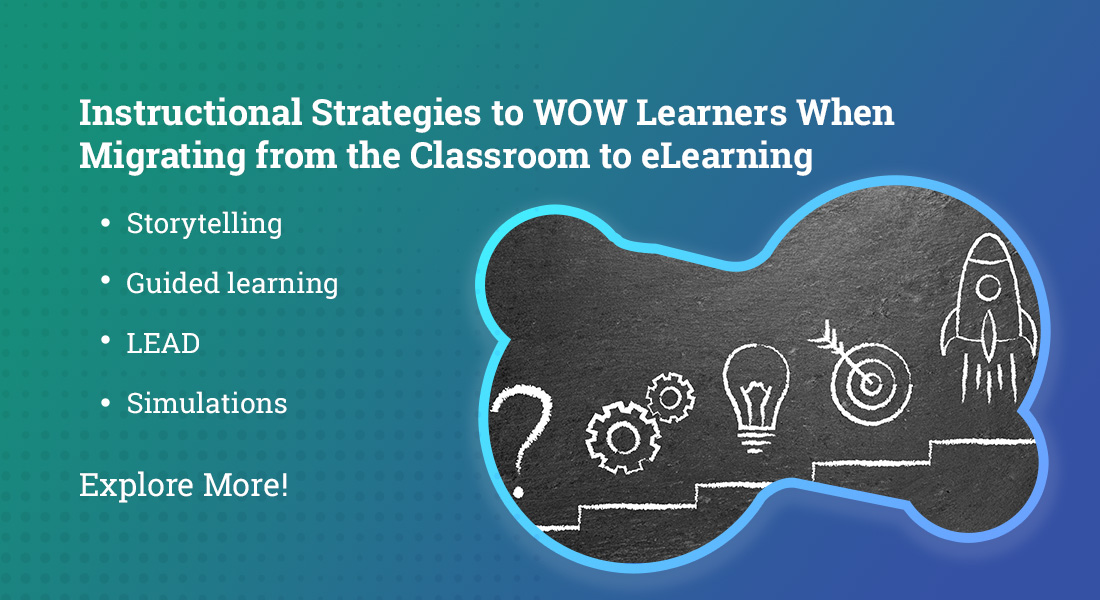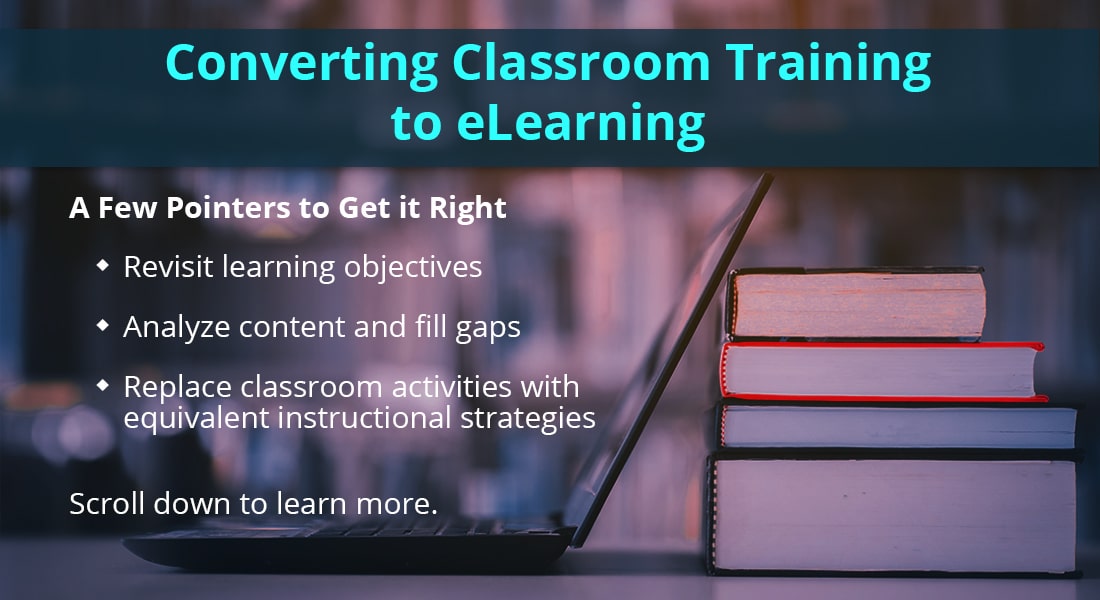Transform Classroom Activities to Fit Your eLearning Strategy: Unveil the Possibilities
Classroom activities can be converted to fit an eLearning strategy. Know how classroom role plays, quizzes and more find a place in your eLearning strategy.

According to ATD’s State of the Industry Report in 2017 classroom training was the primary delivery mechanism, accounting for almost 54% of the total learning hours. Classroom training or instructor-led training (ILT) continues to remain the favorite of corporate trainers for its human touch. Classroom training makes learning dynamic with interactivities and discussions. However, with many organizations converting ILT to eLearning, are we going to miss out on these classroom activities? Can they be incorporated in your eLearning strategy?
4 Classroom Interactivities that can be Used in Your eLearning Strategy
- Convert role plays to scenarios
- Convert classroom quizzes to assessments
- Include Classroom Demos as Video-based Courses
- Include Group Discussions as Collaborative Learning
While planning to move from ILT to eLearning, there are several considerations to be taken care of. Ensuring that the eLearning course has an appropriate level of engagement to hook learner attention just like an ILT session is one among them. We can achieve this objective by tweaking classroom activities such as role plays and quizzes to fit your eLearning strategy.
How to Fit Classroom Interactivities in Your eLearning Strategy?
1. Convert Role Plays to Scenarios
Role-play with peers where learners put themselves in imaginary situations or assume the roles of senior managers, clients, and partners is a major part of ILT-based training programs. Classroom training uses role plays customized to unique training requirements to improve workplace skills as well as to provide employees an opportunity to learn how to execute the skills in real-life situations. How do we include this in our eLearning strategy?
Scenario-based learning substantiates the purpose served by role-plays and engages learners. This instructional design strategy is gaining popularity among corporate learners, especially for case-based or problem-based training programs such as customer service, leadership, team-building, and conflict resolution.
The risk-free and real-world-like context offered by scenario-based courses motivate learners and give them the confidence to practice skills and solve problems. Using the in-built character library of rapid authoring tools such as Articulate Storyline, Adobe Captivate, and Lectora Inspire helps develop scenarios quickly and easily.
2. Convert Classroom Quizzes to Assessments in Your eLearning Strategy
In a classroom session, learners are posed questions on the subject and this puts them at the advantage of receiving instant feedback from the instructor. How do we substitute these classroom quizzes in eLearning? How do we assess the impact of training on learner knowledge?
Formative assessments at the end of each topic within an eLearning course enable learners to check their understanding and retention. These assessments raise the interest quotient among learners with eLearning interactivities in the form of crosswords, puzzles, drag and drop activities, etc., and provide them an opportunity to self-evaluate and identify areas that require improvement.
Taking this to another level, eLearning also offers the opportunity to include summative assessments at the end of every course, much like the pen and paper test at the end of a classroom. On the completion of a full-length eLearning course, learners can be complemented based on their performance with rewards in the form of badges, coins, and points, thus boosting their interest in receiving further courses and bettering knowledge.
3. Include Classroom Demos as Video-based Courses
Demonstrations play a significant role in molding learner perception over a subject and enhance their understanding. The use of demonstration is an effective training platform in classroom training, especially for skill-based training. How do we provide a comprehensive picture of a production process or the parts of a machine through online training?
Video-based learning as an instructional strategy has accelerated globally among corporate employees and taken the central stage for the high recall and retention rate it offers. You can incorporate micro videos in your eLearning strategy. These videos shared via mobile devices illustrate concepts and processes in an effective way, which would otherwise take hours in a classroom setup. Short video nuggets enable learners to watch and repeat watching a course until they get the point.
4. Include Group Discussions as Collaborative Learning
Imagine an ILT session with your managers sharing their work experiences, where they discuss their daily challenges or senior sales reps sharing how they dealt with different types of customers. Wouldn’t it be a compelling and interactive session? Can this find a place in your eLearning strategy?
A similar exchange of ideas and views can be promoted in digital learning in the form of virtual classrooms and online forums. Globally dispersed employees can widen their horizon of knowledge by virtually coming together at a given time. To enhance the level of interactivity of this virtual classroom, we can keep the course content activity-heavy and text-light.
Collaborative tools such as online discussion forums, polls, and virtual classrooms ensure active participation among learners and create opportunities for them to collaborate, ask questions, and share thoughts.
Classroom activities, when incorporated in your eLearning strategy, facilitate a dialogue between the learner and the online course, enabling learner engagement and dynamic learning. However, ILT to eLearning conversion is not just a question of converting ILT activities to fit your eLearning strategy. We also need a well-defined process that can guarantee learner-centric courses. To know the process and to get eLearning implementation right, check this eBook.





